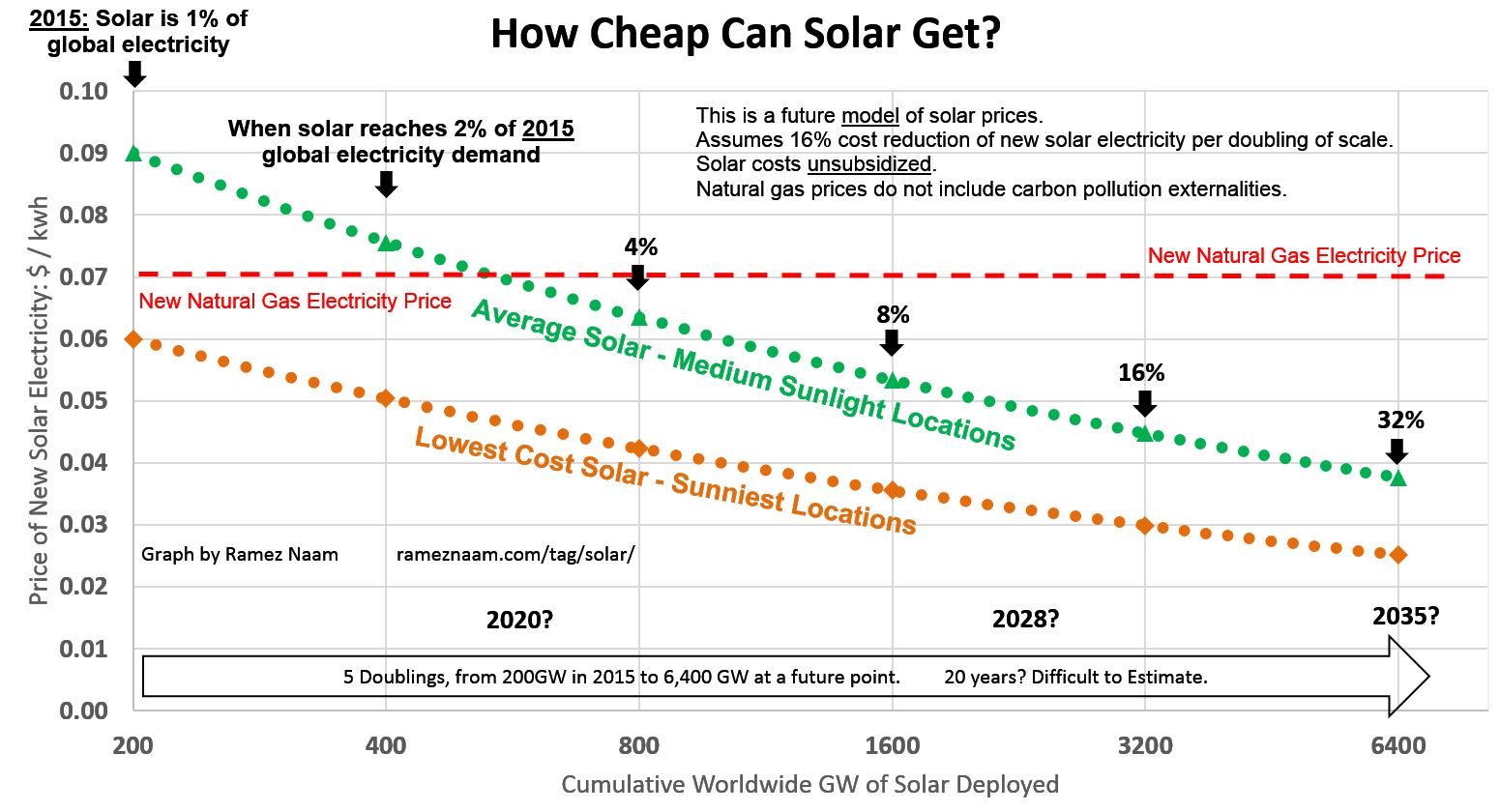Solar
Mechanisms
- Photovoltaic: light converted to electricity (can be concentrated)
- Solar thermal water heating: heat water from the sun. 1 in 10 houses in China, not so many in the States Lovins, 66
- Concentrating solar power (CSP): mirrors to concentrate and reflect sunlight onto a collector. This can be used with solar thermal or with photovoltaics.
- Solar thermal: CSP is used to create thermal energy, which is typically harnessed to heat salt (which can store thermal energy) and in turn to heat water to drive a steam turbine generator. Types include linear concentrator, dish/engine, power tower, and thermal storage Doris, 12, Muller, 152
Materials
- Main photovoltaic technologies: silicon crystals, cadmium telluride (CdTe), copper indium gallium selenide (CIGS), amorphous (glass like) silicon, multijunction cells Muller, 153
- Silicon is cheap in materials (found in sand) but can be expensive to process and is brittle. CdTe is thin and therefore flexible, but Tellurium might be a constrained resource (we aren't sure). Additionally, Cadmium is toxic. PV cells are typically sealed, but this could be a PR problem in home PV systems. CIGS is flexible and nontoxic, but indium is expensive and rare. Muller, 154-6
- Multijunction cells are the current highest efficiency PV technology– they have layers for each wavelength of light. Cost is around $500/square centimeter. They are usually used in concentrator PV arrays, so positioning and maintenance is typically the highest cost, rather than the PV cell itself Muller, 157
- Silicon-based PV systems are produced primarily in China; CdTe and CIGS systems are primarily produced in the U.S. Muller, 154-6
Feasibility of large-scale deployment
It's happening in the U.S.:

- Electric demand of the U.S. could be met by covering 9% of Nevada with PV according to DoE report Lovins, 72
- Distributed PV generation was 4 GW worldwide in 2003, 128 GW in 2013 EPRI, 11
- Solar has installed capacity of 137GWs worldwide as of 2015. The majority is in developed economies. IFC, 3
- Solar is expected to increase by a factor of 10 from 2015-2040: 25 up to 246 GW (with CPP) or 202 GW (without CPP) EIA, 114
- Because wind requires HVDC to to continue growing, solar capacity is expected to surpass wind capacity by 2032 EIA, 114
- CSP in the United States makes the most economic sense in the Southwest as a utility-scale plant Doris, 12
- CSP can be deployed on landfills, brownfields, and greenfields with minimal disturbance to the land Doris, 12
Economics
- "This is a ~16% learning rate, meaning that every doubling of utility-scale solar capacity in the US leads to a roughly 16% reduction in the cost of electricity from new solar installations." Naam
- "If current rates of improvement hold, solar will be incredibly cheap by the time it’s a substantial fraction of the world’s electricity supply."
 Naam
Naam - At the scale of utility installations, the cost of solar modules are now less than half of the price of deploying solar. Inverters, labor, grid connection, and other soft costs are now higher. Naam
- Cost of solar PV power plants has decreased 80% in the 2008-2015 period IFC, 3
- Solar capacity in the United States is expected to rise steadily through 2040 as a result of the declining capital cost of installation and from ITC incentives EIA, 112
- Residential solar benefits greatly from its connection to the grid. EPRI estimates that a grid-connected system costs ~$51/month (2014) whereas an independent solar installation would cost 4x that EPRI, 7
How to
- Detailed 2015 guide to the siting, building, and operation of a solar site available here
- Key components to solar farm design are PV plant design, available solar energy resource, energy yield, and site selection IFC, 5
[aggarwal]: https://www.sciencedirect.com/science/article/pii/S1040619013001917 "Aggarwal, Sonia and Harvey, Hal. 'Rethinking Energy Policy to Deliver a Clean Energy Future.' Energy Innovation, 2013."
[trabish-dynamic]: https://www.utilitydive.com/news/beyond-tou-is-more-dynamic-pricing-the-future-of-rate-design/447171/ "Trabish, Herman. 'Beyond ToU: Is more dynamic pricing the future of rate design?' Utility Dive, 2017."